Thursday, April 21, 2011
Wednesday, August 26, 2009
Laughing Out Loud And Other Inuit Values To Keep Your Company From Chillin' Out
“We try to hire local Inuit, but they have little education and so it’s hard for us to give them anything but the most menial jobs,” said the mining engineer sitting next to me on the flight from Yellowknife to Cambridge Bay, a small Inuit community on the edge of the Arctic Circle. It’s a familiar story and makes sense on one level since seventy-five percent of Inuit do not graduate high school. On another level though, that engineer couldn’t have been more wrong.
I first visited Nunavut in 2006. I had spent twenty years as investment analyst and portfolio manager, assessing companies for their investment potential. Others told me that I was good at it, but in the wake of the Enron and Worldcom scandals, I became aware that I was losing a grip on my craft. As an outsider, I could perform all the sophisticated and complex financial analysis in the world, but if a company had lost touch with it’s fundamental human values, no amount of number crunching would help me in the long run. I had no techniques to protect against moral bankruptcy. So, I decided to jump ship before it got worse – and it did.
For a complete change, I went to Nunavut, for reasons that are still not totally clear to me. I’ve returned many times and through my interactions with and observations of Inuit, I have grown to appreciate the power of Inuit Qaujimajauqangit or IQ (an Inuktitut phrase meaning “knowledge, which has long been known”) - a formal set of rules that guide and influence ethical behavior of Inuit, even today. I must qualify this by saying that I’m neither a scholar of nor an expert in this ancient system, but merely an observer.
Modern society appears to be quickly taking over in most Inuit communities. But, behind the ubiquitous satellite dishes, cell phones, SUVs, junk food and MP3 players, is a culture that remains rich in tradition, with survival and subsistence strategies that would make many a management consultant drool.
Whether it is society as a whole or a corporation that is an integral part of that society, survival is a cultural issue and more specifically, the human values inherent in a culture will ultimately determine its fate.
In my experience as an analyst, many companies fail in the long run because they somehow lose a grip on some very basic human values that defined them at the outset. The last couple of years have provided numerous examples of this phenomenon. It doesn’t matter how good your product is or how smart your people are, if your employees cannot relate to each other on a basic, civilized human level, the company is ultimately doomed.
Inuit have survived and will continue to do so because their values are such a stable, unquestionable and unconscious part of everyday life. For sure, they may have more access to modern conveniences today and are experiencing the societal problems associated with this, but how Inuit respond to each other on a human level has not changed in centuries.
The point here is, everything evolves, but human values should remain stable and at the core of any society, including a corporate society. The problem with many companies is that as the business model changes and evolves over time, so do the values. Somewhere in the chase for quarterly earnings performance and growth, human values get diluted or lost completely and when this happens, the resulting behavior of corporations can have a devastating effect on the societies in which they operate.
The drum used in traditional Inuit drum dancing is a symbolic instrument. The centre of the drum represents Inuit values. The strength of these values in turn, shapes the strength of the people. Values influence learning mechanisms and also define what Inuit view as important knowledge to pass from one generation to another (which is depicted in their traditional songs). Surrounding the centre of the drum are the determinants of health, well-being and community conditions that impact learning. These factors define the collective strength of Inuit and are seen as having an overall effect on the learning potential of individuals.
Every company should have its own version of the drum. The values that have sculptured Inuit psyches for two thousand years can be applied to any corporate entity today. They act as an “archetype” in a purely Jungian sense – a collectively inherited unconscious pattern of thought that can be applied to any individual.
Admittedly, it is now a cliché to say that a company’s assets go up and down with the elevator. What is not so banal is to say that those same assets are intrinsically linked to the survival of a company via a system of very basic human values. Values are at the core of Inuit culture and should be at the core of any culture, corporate or otherwise. Humans are humans, regardless of whether they live in the Arctic or Wall Street.
Respecting elders. In Inuit communities, the oldest person is always the most important. In the old days, incompetent people did not live to an old age. Elders, by definition, were held in high esteem because they had lived a long time, thus proving their competence. Elders not only have more life experience, but are also repositories of knowledge accumulated over many generations. For these very practical reasons, Inuit look to their elders for leadership.
Though many companies today embrace some form of mentoring program, it tends to be based on hierarchy rather than experience. For example, a 40-year old superstar Vice President might become a mentor to a 45-year old employee somewhere down the corporate ladder. It is rare that age is viewed as an asset in and of itself within a corporation, although at the board level, it is often the case that counsel comes from retired executives of age, sometimes from completely unrelated industries. Why should only the very top-level management have access to elders? Why can’t advisory committees comprised of elders with appropriate experience be set up to serve middle management and lower? Many retirees with valuable expertise and experience would welcome the opportunity to play the role of coach for one or two days a month. I know someone who founded an investment bank and maintained an office at his company well after his official retirement date. He literally just hung out there for a couple of days a week and consulted with anyone who cared to walk into his office, regardless of rank. He was regarded as one of the firm’s greatest assets and many senior executives in the investment business today owe their careers to his wise counsel.
In some aboriginal communities, it is said that when an elderly person dies, a whole library of knowledge dies with them. Why do companies choose to retire that library of knowledge before it is absolutely necessary? They should do more to harness this collective intelligence.
Making decisions through consensus and discussion. Most aboriginal cultures, including Inuit, embrace the concept of the “sacred circle”. If there is a problem to be solved, any member of a community regardless of age, gender or status can elect to join the circle. A rock is passed around and the person holding the rock states his or her views on the issue at hand. There’s no judgment, no disagreement, no discussion – it just is. The rock is passed around the circle until all that can be said about an issue has been said and the solution to the problem becomes clear and self-evident.
The main message here is that everyone’s viewpoint is important and valid, there is no intellectual hierarchy involved in the outcome and decisions are not forced, but arise as a result of the process. In essence, it’s the process that solves the problem, not an individual.
I’ve experienced corporate environments that try to engage in this type of collective decision-making, but it’s often flawed. Meetings are called, opinions gathered and the boss then makes a decision, usually too quickly. Rarely are discussions exhausted and participants often engage in what behavioral psychologists call confirmation bias – a tendency to cognitively overweight confirming evidence and underweight disconfirming evidence.
The sacred circle requires faith and trust in the process. It also requires patience and time - the real or metaphorical rock has to be circulated until a solution becomes self-evident. Like the human body, the process has its own natural rhythm and is not governed by the clock. If you allow the process to unfold naturally, you will find that the resulting solution has a different quality to it. The decisions that ensue carry more of a collective responsibility and are free of the competitive tension that is often evident in regular corporate decision-making processes.
Being Innovative and resourceful. At one time, everything the Inuit needed to survive – food, clothing, and shelter - came from the land. Needless to say, they had to be extremely innovative and resourceful. If you’re ever lucky enough to camp, hunt and fish with Inuit elders, you will marvel at their creativity and ability to do so much with so little. But, these abilities seem to have their root in the concept of serving others. In essence, the more innovative and resourceful a person is, the more they can give to others. To describe this better, I’ll borrow a Buddhist term called right effort, albeit within an Inuit context.
Today, youth-elder camps are held throughout Nunavut to teach kids traditional Inuit survival skills. An unintended consequence of this is that Inuit youth begin to understand the concept of right effort - always doing your best with whatever resources are available to provide for family and community.
Companies try to analyze effort by measuring productivity or more recently a concept called return on effort. But, this is like writing down an improvised piece of music after it has been played. It may be a useful analytical tool, but it fails to capture the mental energy that produced the music in the first place.
Effort is about mental energy and right effort is about creating environments that make people “want” to do things rather than “having” to do them. We have all heard of leaders who inspire their teams to work above and beyond what is expected of them. A common thread in leadership research is that good leaders always lead by example. This phenomenon is played out in interactions between Inuit elders and youth. Inuit elders always show and rarely tell.
Another important aspect of right effort is a sense of “giving”. The purpose of hunting in Inuit society is to provide for family and community. Even today, many Inuit communities have communal meat caches that anyone can access. If a person hunts, he takes only what he needs for his family and shares the rest with the community. The concept of sharing is so ingrained in the Inuit psyche that once I gave a chocolate bar to an Inuk kid at the airport and he broke it into five perfectly equal portions and shared it with his four friends. So, the point is, when Inuit do something, they do it for others as well as for themselves. The consequence of being innovative and resourceful is that it results in being able to give more to others. It is this sense of giving that motivates young people to want to learn traditional skills and ultimately work for the benefit of their communities (unfortunately, this has not yet been recognized in the school curriculum).
In a corporate context, Right effort at the employee level should, in theory, be inextricably linked to return on investment at the enterprise level.
Working together for a common cause. What I have observed about modern Inuit is that there is little difference in their behavior inside and outside of the workplace. Of course, there are exceptions and “office politics” do exist, but by and large, the same values hold true inside the workplace as they do out. Much of this has to do with the size of the communities, which are still relatively small - less than 1,000 people in most cases. In other words, you generally have to live with the people you work with.
But, there’s something more to it than that. On the whole, Inuit are not “measurers” by nature. In “modern” society, most human interactions are a chance to engage in some form of measurement. We measure whether someone is good-looking, smart, wealthy, educated, useful etc. We have become so good at it that it’s not even a conscious process anymore - we have already decided whether a person “measures up” within the first few seconds of meeting them.
In traditional Inuit societies, if you were part of a functioning community, that was all the qualification you needed. Everyone was welcome and included, because everyone had a part to play in the community as whole. The harsh Arctic environment took care of the measurement part – if you didn’t perform, you simply didn’t survive.
In the modern workplace, Inuit assume that if you’re there, then you’re part of the community. There is little evidence of clique or silo mentality, where groups are formed around some predetermined qualification, measurement or in some cases, emotional insecurity. The community works together as a whole and everyone has a valid opinion, which carries equal weight in the decision-making process. The community is always more important than the individual. The whole is always more than the sum of the parts.
Developing skills through practice, experimentation and action. There are some things that just cannot be rushed and some skills only elders can possess. Every Inuit youth knows and understands this. Inuit also seem to intuitively understand that experience has its roots in experiment. Watching, learning, experimenting, making mistakes and celebrating small successes are at the heart of traditional Inuit learning methods.
It’s fascinating to watch Inuit elders teach traditional tool-making skills to young people. It’s a very quiet process - little is said, but much is shown. Additionally, everyone is welcome to try, there’s an implicit understanding that learning has its own natural rhythm and is a life-long process.
Today, there is much angst in corporate HR departments about how to deal with the restlessness, impatience and general sense of entitlement of the Millennial Generation (those born after 1981). Many companies spend large amounts of money training these young employees only to find that they will jump ship without blinking an eye, leaving a company with little or nothing to show for its investment. Companies need to figure out how to deal with this in order to maximize their “Return on Investment in Millennials (ROIM)”.
Much has been written on how to get the best out of Millennials. Ironically, what is most striking about this research is that it illustrates that this demographic cohort is inherently a values-based generation. It’s a generation that was raised with a strong sense of community (albeit a digital one) and uncompromising social ideals (it has the highest volunteer rates in history).
During my visits to Nunavut, I have worked a lot with Inuit youth. If you ask a group of Inuit teenagers to draw their ideal man or women, they invariably draw a facsimile of their grandparents. When pressed to explain their drawings, it appears that it’s not so much the personification of their grandparents they idealize, but rather the values they perceive are inherent in this generation. In other words, they are reacting to an archetypal quality of that generation.
I’ve also tried this exercise on youth living in the south from a variety of cultures and nationalities. Even when material objects, such as cars or clothes factor into their renditions, they’re often associated with deeper ideals. For example, in a recent exercise in an inner-city school in Toronto, when asked why their ideal man was wearing Hip-hop clothing, the group responded by saying that clothes represented authenticity, not fashion. Other words used to describe their drawings included integrity, honesty, warmth, imagination and friendliness.
The point here is that the millennial generation is the key to strengthening corporate values. They have a lot to offer and in return they simply ask for a sense of community, participation and recognition. They will respect and respond positively to a system that embraces all the things I’ve discussed so far. That’s why they should be listened to carefully and their opinions given equal weight in the decision-making process. In a sense, this is a nice bookend to the first value I discussed – respecting elders. Wouldn’t it be interesting to hear a group of Millennial employees give a presentation on corporate values to a Board of Directors? Would it be very different to one given by elders?
Laughing out loud. This is not really a part of the official Inuit Qaujimajauqangit, but I thought I’d include it here because it’s a trait that I notice the most when I’m with my Inuit friends. When I first visited Nunavut, I asked someone who had lived there for a while what I needed to know about the Arctic. “You need to know how to laugh” was his response. Real laughter, the type that emanates from your belly, is such a natural part of life for most Inuit that it makes you appreciate how much it has been lost in our own cultures, especially the workplace. Why is smiling and laughter regarded as a weaknesses in the workplace? To be sure, there is seriousness to business, but if the workplace can embrace other “softer” emotions, why can’t it embrace laughter too. Besides, laughter keeps you warm in so many ways.
There is a common thread running through all these values - they a deeply anti-narcissistic. Narcissism is rampant in corporations today, but to strengthen any values-based organization, people have to believe that they belong to a community in every sense of the word. Trust, integrity, honesty, inclusiveness, participation and respect will always win out over personal advancement at the expense of others. Everything Inuit do is collectively driven – unfortunately, even suicide is regarded as being for the benefit of family and community.
In the old days, Inuit hunters used materials taken from their prey for their hunting equipment. They recognized the irony of harnessing the sacred power of an animal to use against others of its species. They appropriated both the actual and the spiritual powers of predators to assist them in their hunt. To use these powers, hunters had to show the animals proper respect by taking good care of their hunting equipment. It had to be mended and kept clean and free of contamination, otherwise, a cloud of impurity surrounded the hunter, making him visible to the animals and angering Nuliajuk, the spirit who controlled access to sea mammals.
In order to thrive, companies need to recognize that values are basic survival tools. They harness all the powers necessary for a corporate society to grow and flourish responsibly. They should be looked after and kept free of contamination. Only then, will the spirit of capitalism provide access to all its riches.
If you ever feel the need to question the resilience of these traditional Inuit values, try sticking your head in the freezer for ten minutes and imagine trying to come up with coping strategies that would allow you to survive in these climatic conditions permanently. You’ll quickly realize that the only ones that make real sense are those that rely on others around you. Laughing out loud is also helpful!
Tuesday, August 25, 2009
Inuit Youth Have A Voice Too

The first line of the chorus from the song “Teenagers” by the band My Chemical Romance is, “Teenagers scare the living sh*t out of me.” For most of my adult life, this could have been my mantra. Quite frankly, I found teenage coolness intimidating and always dreaded or avoided interacting with them. I’m also of an age where I can barely remember the details of my own adolescence.
Today, I actually really want to be around young people. That’s been a big change for me. I’ve learned I can connect with a teenager. I never thought that would be possible until I started working with Inuit youth.
I first visited Nunavut in 2006 in search of something good. Ever since Nunavut was formed just over a decade ago, the majority of reports have been only of its socio-economic failures. Generally, when I only see bad, I know there is something good just around the corner. It didn’t take me long to find it.
Upon arrival, I met Lori Idlout. She introduced me to a stunning culture—one of gentleness, kindness and generosity. What I saw did not wholly reflect what the media portrayed.
Lori is the executive director of the Embrace Life Council (ELC), an organization dedicated to working with youth in Arctic Canada. As we have witnessed in the series of media reports on Nunavut this week, young people in the North have issues, to say the least. The ELC’s mandate is to empower these youth to act and think positively and to celebrate their life, culture, language and history.
In 2008, despite my lack of experience working with youth, I was asked to help as a photography facilitator on an Embrace Life Council initiative called “Inuusivut” (meaning “Our Way of Life”). The main focus of this project is to provide the necessary skills-based training in photography, filmmaking and leadership to enable youth to be the driving force in the visual exploration, promotion and sharing of mental health related issues. In short, two Inuk filmmakers and myself travel throughout the Territory teaching a variety of visual communication techniques to groups of kids aged between fifteen and nineteen. So far, we have trained about one hundred and twenty youth in twelve communities.
It was especially challenging for me to take on this initiative because there were many barriers that had to be broken down before I felt I could connect with Inuit teenagers. I had to earn their trust not only as an adult but also as a stranger - or Kabloonak - in their community.
We teach about fifteen kids at a time and our 7-day workshops usually begin with an introduction to camera mechanics and basic visual composition. After a day or so of playing and experimenting, the youth are ready to work on their individual projects; either a photo-essay, multi-media project or short film. The ideas are storyboarded and scripted as best they can, shot and then edited to final production using state-of-the-art equipment. At the end of the week, we have a public showing where family and friends are invited and the kids get to stand up in front of an audience to introduce their projects. For most Inuit teenagers who are naturally extremely shy and quiet, this can be a daunting task.
The kid’s projects are mixed and always interesting. They sometimes tackle difficult subjects such as sniffing, bullying, the environment and those memorable and pesky adolescent relationships - subjects that are almost impossible for them to verbalize, but somehow come alive when cameras are put in their hands. The projects also seem to have an interesting mix of Northern and Southern sensibilities, often captured in their use of both English and Inuktitut languages – or Inuklish as we call it.
I’ve come to believe that art is part of an Inuk kid’s DNA. The level of artistic and visual acuity is nothing short of astonishing. When we show them what they’re capable of, it has a very positive effect on their well-being and mental health. Getting them involved in documenting their community not only encourages active participation, but it also turns the focus from death to life. Through this kind of communication process and participation, we hope that the youth will not get sucked into the funk that creates a cycle of failure, which in the worst of cases, leads to substance abuse and all too often, suicide.
John Ralston Saul, in his book “A Fair Country”, states that “a successful Northern strategy means Northern communities made stronger in a Northern way, which means approaches not imitative of Southern urban beliefs, but approaches naturally integrated as a blend of old and new Northern ways.” From my viewpoint, the first place to start with such a strategy is with Inuit youth.
At one of our public showings in Rankin Inlet, I was asked to say a few words. I told everyone that I had started the week teaching basic photography and ended the week trying to replicate some of the photographs taken by the students. I also wanted to say that nowadays, the only thing that scares the living sh*t out of me about teenagers is their immense creative potential and raw intelligence. But I didn’t think that would translate well into Inuktitut.
Monday, August 24, 2009
Time Flies
Tuesday, March 27, 2007
Inuk Kid

Inuk Kid
Originally uploaded by John Hasyn Photography.
It doesn't seem like almost 9 months since I last updated my blog. How time flies. It's fitting though that my last post was about Nunavut because I just spent the last couple of weeks in Baker Lake, Nunavut attending the 2007 National Elder & Youth Summit. You see, since I went up there last summer I've been doing some projects for a charity called the Embrace Life Council: taking photographs and producing a brochure to send around schools and communities. Anyway, the summit was a great place to take more pictures of youth and also include elders. This time, however, I interviewed my subjects about some of the issues the Inuit face in Northern Canada. Still going through the edit, but I hope to produce a podcast to support this ongoing project. If you want to see more pictures of Nunavut and the summit you can see them on my site at www.johnhasyn.com.
Wednesday, August 09, 2006
Philip "Phat Philly" Ningeongat
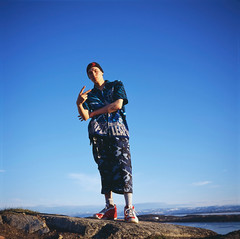
Philip "Phat Philly" Ningeongat
Originally uploaded by John Hasyn Photography.
To see more photos of Inuit Youth and Iqaluit go to my webiste at www.johnhasyn.com.
Thursday, February 02, 2006
Trapped On The Rock
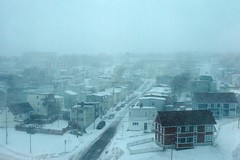
St John's
Originally uploaded by John Hasyn Photography.
I don't think I've ever been in a place that has had so much snow over a 24 hour period. But, here I am in St. John's Newfoundland and almost without warning yesterday, a storm came in, first from the west and then from the east to dump a total over 50 cms. Of course, all the flights out were cancelled and now I can't get on one until 4.45pm tomorrow. Oh well, may as well play tourist for a couple of days!
Monday, January 30, 2006
Does Andy Scott sound like an Aboriginal Name?
While in Saskatoon last week, I picked up a book by Harold Lerat
called "Treaty Promises: Indian Reality." It reminded me how ignorant
I am about the Indian situation and its history here in Canada. I
come from England where the only education I received on Indian
Affairs was from John Wayne movies. This is surprising since the
English were largely responsible for stealing other people's land
around the world in the 19th century. You would have thought we would
have learnt something from the mistakes they made. Anyway, my visit
to Saskatoon, with its large aboriginal community, has prompted me
to start reading and researching a lot more about the current
situation in Canada. For some time I've had a desire to produce a
photo essay on youth culture among the Inuit and will probably still
do this. But, I think it would be interesting to broaden this project
to include aboriginal communities as a whole. The suicide rate among
aboriginal youths is about 10x the national average. Why do things
remain so bad for these communities in this day and age? Why is the
Minister of Indian & Northern Affairs a man named Andy Scott? Could
we not have that department represented by an aboriginal? These are
some of the questions I'd like to explore over the next few months.
I'll keep you posted.
Wednesday, January 04, 2006
There Is Hope!
A friend's son asked me to make a presentation at his high school
about my trip to India. It was a grade 11 world politics class and so
I biased the conversation & debate toward international aid and the
roles of the UN, IMF and the World Bank. I used my trip to India to
illustrate one of the more successful programs administered by the UN
(WHO). I was so impressed with the intelligence and awareness of
these kids. Considering that my generation (the baby boomers) are
responsible for much of the mess we see in the world today, the onus
is on these younger kids to attempt to put things right. A huge
responsibility! I'm sure I was pretty ignorant when I was 16 and
certainly didn't know (or even want to know) anything about world
politics. But these kids understood and were able to debate the
central issues around poverty and health. They were also very attuned
to how fortunate they are and the need to share and maybe even change their lifestyles a little.
On a different note, check out my new website at www.johnhasyn.com. I'm now totally in control of the design and content and I'm very happy with it. Thank you Lena Ho of Allina Creative Designs for all the great work you did on my previous site.
Wednesday, November 16, 2005
Website Update
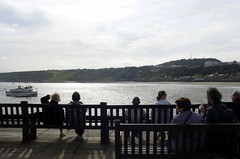
DSC_6693
Originally uploaded by John Hasyn Photography.
I've been updating my website (www.johnhasyn.com) over the last week with lots more pics on the "photo stories" tab. Just like the above photo of the Scarborough pier in north eastern England brings back memories of my childhood, another strange thing happened to me this week. The first time I went to northern Ontario about 20 years ago I discovered the fabulous Highway Book Store on HWY 11 in Cobalt. If you've never been there it's an institution and definitely worth a visit. The shelves are stacked 3 deep in places and there are always many surprises behind the front row of books. Anyway, this week I was given an assignment to photograph the owners - Dr & Mrs Pollard, for Cottage Life Magazine. I've always wanted to do a little photo essay on this store, which prides itself on being open 365 days of the year. It's a real treat for me to go and photograph up there and I'm looking forward to seeing the results!
Tuesday, November 01, 2005
Vancouver to Calgary
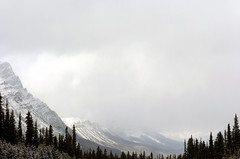
DSC_9443
Originally uploaded by John Hasyn Photography.
I just finished a drive through the Rockies from Vancouver to Calgary, mostly along HWY 1 (Trans Canada Highway). The weather wasn't that great but it made for some great photo ops.
Thursday, October 13, 2005
Bach Is My Excuse!
Saturday, September 10, 2005
Visa Pour L'image
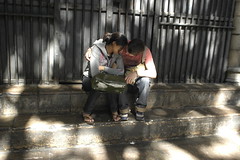
_DSC3786
Originally uploaded by John Hasyn Photography.
Just got back from 2 weeks in France & Spain where I attended Visa Pour L'image, the largest photojournalism conference in the world, in Perpignan. It was incredible to see the diversity and quality of work that is being done today, especially considering the difficulty of getting anything published these days. Newspapers are hurting economically and are so risk averse that it is difficult to have hard core photojournalism published. Also, a recurring theme at the festival was the level of censorship today, particularly in the US. For example, stories that focus on dead or wounded US soldiers in Iraq are very difficult, if not impossible to publish. Also, stories that seem to favour the "Palestinian angle" tend to get completely ignored in the US. Another interesting thing was the number of pure documentary projects being done and financed purely by grants and private funds. Marcus Bleasdale's brilliant work in the Congo and Heidi Bradner's 10-year project in Chechnya come to mind. One thing is certain: there is no money in photojournalism, although it must be one of the more satisfying and interesting ways of working in photography. When I left the festival, my mind was very much on war, conflict and the starving and poor. After visiting the Museum of Catalonia in Barcelona, it really struck me that what we are seeing in Africa today is no different from what we experienced in Europe and Asia during the last 1,000 years. For example, wars fought over diamonds in the Democratic Republic of the Congo today are no different from the salt wars, opium wars, Spanish conqests, Christian crusades and many, many more examples of rape, pillage and plunder throughout the ages, including the oil wars of today. Same issues, different places, different times. It is hard to believe that things will ever change.
On a more cheerful note, I learnt today that I placed second in the medical category at the International Photography Awards for my portraits of cured leprosy patients. Considering there are over 25,000 entries from around the world, I would have been happy with an honourable mention. I'm over the moon with a 2nd place finish!
Tuesday, August 16, 2005
Tennis & Toronto

_DSC3535
Originally uploaded by John Hasyn Photography.
I decided to spend an afternoon at the Rogers Cup International Tennis tournament on Monday. It used to be called the Players International, then the Du Maurier International, then they did away with sponsorship of sporting events by tobacco companies, so the local cable company took over. Since I last went about 5 years ago, they've built a big stadium and it now feels like a mini-U.S. open. Lots of high priced hot dogs and brand name companies selling their wares. This to me symbolizes the mentality of Toronto. Gone is the quaint city feeling of 20 years when I first immigrated. Now we are desparately creating a mini-New York.
Saturday, August 06, 2005
Taste Of The Danforth
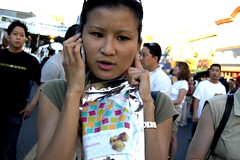
_DSC3373
Originally uploaded by John Hasyn Photography.
Every year about a million people descend on my little Toronto neighbourhood to enjoy what has become the biggest street party and food festival in the city. Danforth Avenue becomes a mass of bodies, food and bare flesh. If I was shooting at 125th of a second, it's unlikely that my eyes could focus for much longer on any specific thing. Click on the photo and go to "Taste Of The Danforth" set to view larger portfolio on Flickr.
Saturday, July 30, 2005
Four Days in the Wilderness
Saturday, July 23, 2005
Festival Time
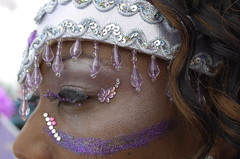
DSC_5446
Originally uploaded by John Hasyn Photography.
Last year, I spent the whole summer photographing summer festivals around Ontario. Click on the photo above to see the full portfolio.
Wednesday, July 20, 2005
A Night At Moorelands Camp

DSC_6126
Originally uploaded by John Hasyn Photography.
Spent the night at Moorelands Camp on Lake Kawagama (see photo above), just south of Huntsville. The camp is run by Moorelands Community Services and offers inner-city, underpriveldged kids a chance to experience camp. My task was to take a group picture of 120 kids to say thanks to the camp's donors. It was great fun. I've been volunteering at a work weekend at the camp for a few years, but have never been there when the kids are there (our work weekend is always on a weekend before the kids arrive). Spent the evening watching a movie with the kids and in the morning managed to marshall all the kids on the dock to take the picture. Set up and picture took a total of 30 minutes. Impossible to get everyone looking at the camera at the same time.
Friday, July 08, 2005
In The Back Seat of a Delhi Taxi
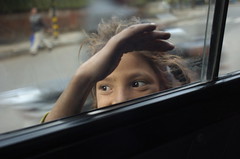
DSC_9475
Originally uploaded by John Hasyn Photography.
This picture is from my "In My Back Seat of a Delhi Taxi" series. To see the full series, just click on the image and go to the appropriately named set in Flickr.
Thursday, July 07, 2005
The New Face of Leprosy
Click on photo for detaied caption.





